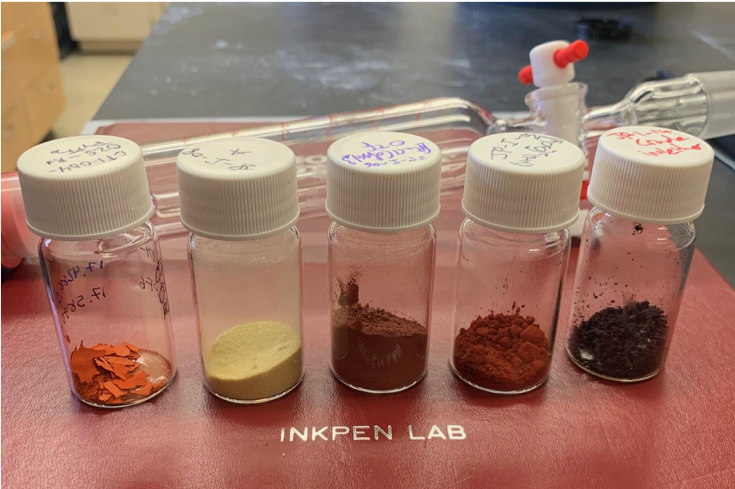By: Joseph Parr
My name is Joe Parr and I am a first-year chemistry PhD student at USC working with Professor Michael Inkpen. As a group, a key focus is to improve our understanding of how charge carriers (electrons and holes) move through molecular-scale materials, before combining these molecules into extended 2- and 3-dimensional frameworks. This allows us to explore electrochemical energy storage capabilities at a molecular level, which we can then use to inform us about which molecules to choose when building battery structures.
I like to think of it like Lego, just at a really, really small scale. We take each individual piece and test its conductance and stability – useful features for battery materials – then combine the most promising pieces into new batteries for sustainable energy storage.

This is how I spend most of my days – wearing a lab-coat, safety goggles and gloves, to ensure I am well-protected should a reaction go wrong.
Our motivation stems from a global need to produce cheap, safe, sustainable sources of energy, in order to address the growing risks of climate change and air pollution. The preceding century saw a drastic change in the way we as humans live our lives, with rapid globalisation sparking a complete overhaul to the mechanisms of our day to day existence. We can now fly across continents, artificially replace lost limbs, and video chat with our families, all whilst watching videos of cats on YouTube. However, these luxuries and this way of life has been built on an unsustainable bedrock, namely, fossil fuels. Alongside the obvious environmental negatives of burning these fuels for energy (climate change, air pollution), this fuel source also has political implications, with certain nations, including my own, the United Kingdom, relying heavily on foreign imports to meet the energy demand.
As a result of this, scientists began to look elsewhere for sources of energy, with an ideal solution being some sort of limitless, ever present, free source of energy, accessible almost anywhere on the planet. They didn’t have to look too far. Our own Sun bestows upon us more energy a year than all of the fossil fuels in the world have ever/can ever provide, and following the discovery of the photovoltaic effect in 1839, we have a means to harness at least some of that energy.
This then leads us directly onto the problem of today; we can convert solar energy into useful electrochemical energy to power our phones, cars, and Netflix binges, but when the sun goes down at the end of each day, we once again rely on fossil fuels. A number of solutions have been suggested toward this problem – with efficient, inexpensive battery technologies that store renewable energy during the day, then release it at night, a promising candidate. In order to develop such devices, we must understand the molecular structure of the battery materials and the mechanism of energy storage, which is where we as chemists step in.

Some of the samples I have made this summer- Inorganic chemistry is fun as often the compounds are bright and interesting colours.
We work on improving conductivity in covalent organic frameworks (COFs), a new class of materials that have shown recent promise as energy storage devices. The current ‘struts’ and ‘nodes’ – or in our analogy, individual Lego pieces – are made predominantly of the elements carbon, silicon, nitrogen, hydrogen and boron, resulting in low conductance through the pieces themselves. By selecting analogous metal-containing ‘struts’ and ‘nodes’, we can improve conductivity without changing the framework structure itself. My research this summer has so far focused developing new, metal-based ‘Lego pieces’, which can then be combined with traditional COF ‘struts’ and ‘nodes’ to create a more efficient energy storage device.
I have been lucky enough to be supported by the Wrigley Institute’s Norma and Jerol Sonosky Summer Fellowship this year, allowing me time to focus all of my efforts on research and playing my own small part in our onward quest for a sustainable energy economy.
I hope this has given you a little flavour toward our motivations and research efforts, with more information available at (www.inkpenlab.org). Thanks for reading!
